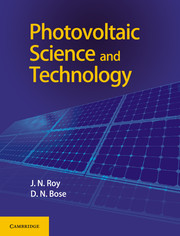Book contents
- Frontmatter
- Dedcation
- Contents
- Figures
- Tables
- Preface
- Acknowledgments
- 1 Introduction to Solar Energy and Solar Photovoltaics
- 2 Crystalline Silicon Cells
- 3 Thin Film Solar Cells
- 4 III-V Compound, Concentrator and Photoelectrochemical Cells
- 5 Organic and Polymer Solar Cells
- 6 Manufacture of c-Si and III-V-based High Efficiency Solar PV Cells
- 7 Manufacture of Solar PV Modules
- 8 Characterization, Testing and Reliability of Solar PV Module
- 9 Overview of Solar PV System Technology and Design
- 10 Design and Implementation of Off-Grid and On-Grid SPV Systems
- Index
- References
8 - Characterization, Testing and Reliability of Solar PV Module
Published online by Cambridge University Press: 05 July 2018
- Frontmatter
- Dedcation
- Contents
- Figures
- Tables
- Preface
- Acknowledgments
- 1 Introduction to Solar Energy and Solar Photovoltaics
- 2 Crystalline Silicon Cells
- 3 Thin Film Solar Cells
- 4 III-V Compound, Concentrator and Photoelectrochemical Cells
- 5 Organic and Polymer Solar Cells
- 6 Manufacture of c-Si and III-V-based High Efficiency Solar PV Cells
- 7 Manufacture of Solar PV Modules
- 8 Characterization, Testing and Reliability of Solar PV Module
- 9 Overview of Solar PV System Technology and Design
- 10 Design and Implementation of Off-Grid and On-Grid SPV Systems
- Index
- References
Summary
INTRODUCTION
Characterization and testing during and after manufacture play important roles for ensuring quality and performance [1, 2] of Solar Photovoltaic (SPV) modules. The in-situ characterization during various process steps ensures that good quality modules with acceptable power output are produced. Testing of SPV modules has additional aspects of authenticity and accuracy of the test results. As the output power of the finished modules decides the DC output at system level, some standards and protocols are to be followed during testing to ensure that correct values are measured. Standards are applicable to the tester, which is also known as a ‘Sun simulator’. The protocol demands that the tester is always calibrated against some reference module during testing of finished modules. The reference modules are to be certified by authorized centres such as NREL, Fraunhofer, CIMET, etc. The modules are tested and the electrical parameters, including power are rated under Standard Test Condition (STC), which is 1000 Wm-2 irradiance incident normal to the plane of module face maintained at 25°C. These protocols and standards ensure that the testing of any module produces the same electrical characteristics, within the accuracy band of the tester used, wherever the module is tested. The accuracy required for the Sun simulator is also specified through a standard. These are very important as the accuracy of the rated electrical behaviour, particularly the power output of the modules, ultimately decide how much energy can be extracted from the SPV system using these modules. Inaccurate measurement of power can have serious financial implications for the seller if the measured power is less than the actual value and for the buyer if the measured power is larger than the actual value. It is also important to measure other electrical parameters, such as VOC, ISC, Vm and Im as the string design for SPV system (Chapter 9) requires accurate values of such parameters. It is possible to have the value of the power output very close to the rated value, but other electrical parameters may have large deviations/inaccuracies. The test protocol and standards addresses such issues as well.
Reliability determines the long-term behaviour of any device or product such as a SPV module. This is particularly important as the modules are supposed to produce power for 25 years or more.
- Type
- Chapter
- Information
- Photovoltaic Science and Technology , pp. 259 - 319Publisher: Cambridge University PressPrint publication year: 2017



